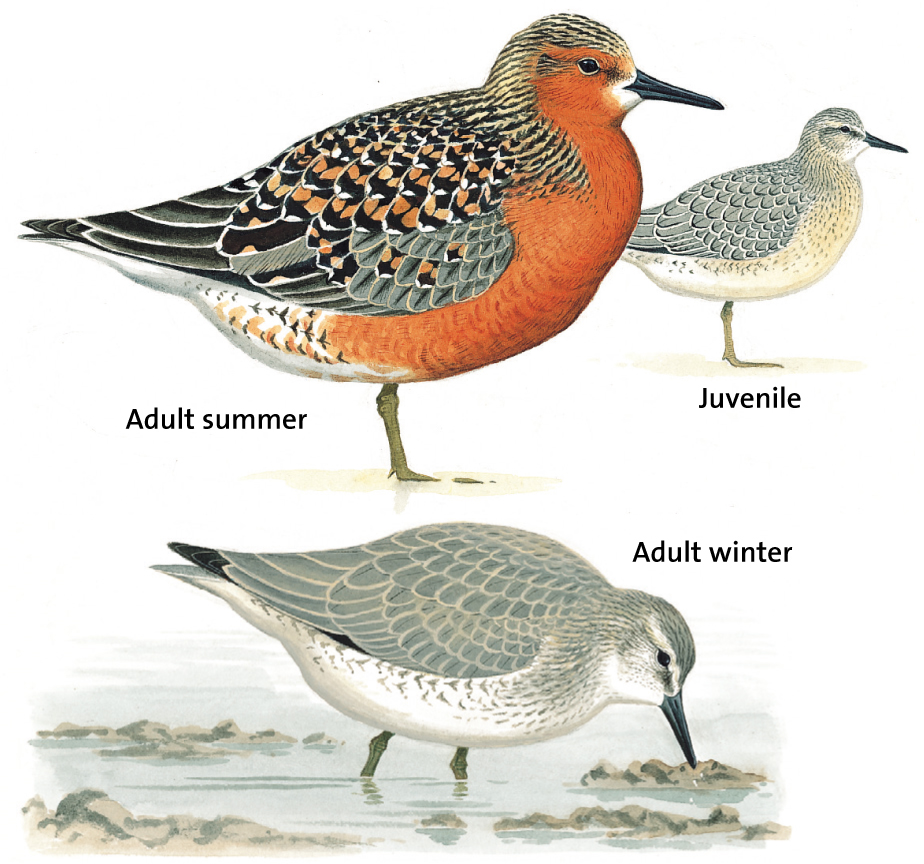
Knot
Calidris canutus

SIZE AND DESCRIPTION
25cm. A little larger than Dunlin, with a comparatively short bill. Winter plumage is grey. Narrow white wingbar. Breeding plumage is rufous.
VOICE
Call ‘knut’.
HABITAT
Breeds on High Arctic tundra. Widespread on mudflats on North Sea and Atlantic coasts during migration and winter.
FOOD AND HABITS
Feeds on invertebrates such as insects, molluscs, earthworms and crustaceans. Usually seen in flocks, which can be very large and dense. Spectacular aerial manoeuvres as flocks come in to roost. Nest a grass-lined scrape well hidden on the ground.
Sanderling
Calidris alba

SIZE AND DESCRIPTION
20cm. Pale grey in winter plumage. Summer plumage scaly brown above and on the breast; white belly shows white wingbar in all plumages.
VOICE
In flight, liquid ‘twick, twick’.
HABITAT
Breeds further north than Britain, where it is a passage migrant and winter visitor confined to coast.
FOOD AND HABITS
Distinctive feeding method as it runs in and out on the shore with the movement of the waves, often likened to a clockwork toy. Nest a grassy cup well hidden on the ground.
Little Stint
Calidris minuta

SIZE AND DESCRIPTION
15 cm. Tiny wader with black legs and a short, fine black beak. Winter plumage (rarely seen in Britain) soft grey with white underparts. Breeding plumage rufous on head and breast, turning buff-brown by July.
VOICE
Call a feeble short ‘pip’.
HABITAT
Breeds on tundra in far north. On passage widespread on marshes and mudflats in coastal areas of Europe.
FOOD AND HABITS
Feeds mainly on insects; also crustaceans and molluscs.
Temminck’s Stint
Calidris temminckii
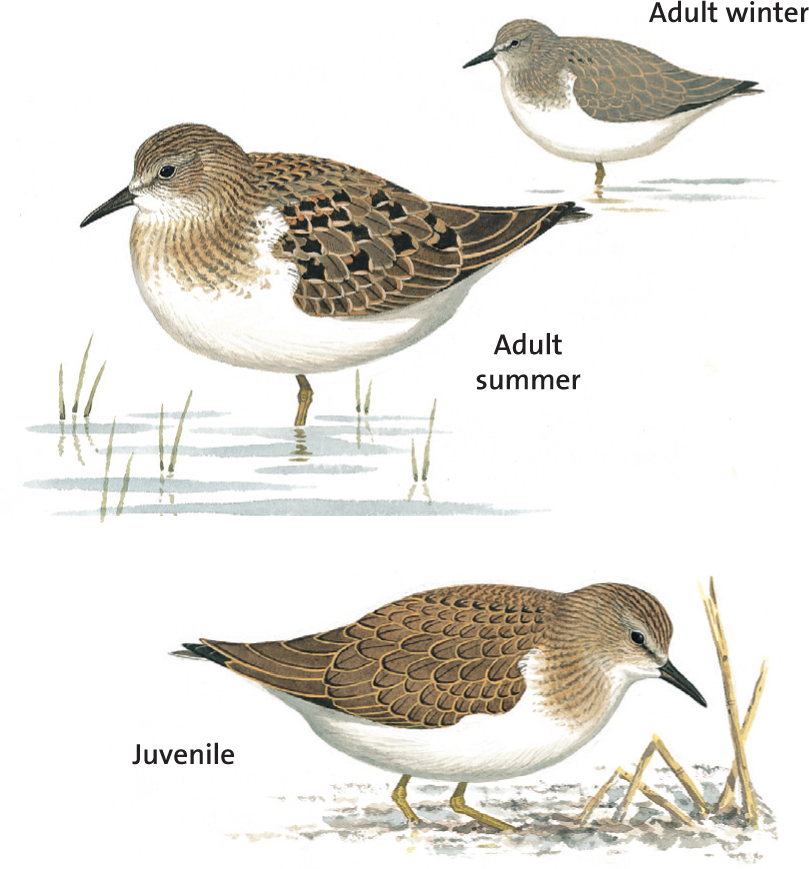
SIZE AND DESCRIPTION
14cm. Shorter-legged with more horizontal and hunched posture than Little Stint, plumage pattern similar to that of Common Sandpiper with grey-brown upperside, white below and white ‘spur’ in front of wing bend. Narrow white wingbars and tail-sides show in flight. Bill short and straight, legs dull yellowish, tail relatively long.
VOICE
Call a soft trill.
HABITAT
Arctic breeder, in Britain rare passage migrant, tiny numbers breed in north Scotland. Small pools, lakes, ditches and marshes, both coastal and inland.
FOOD AND HABITS
Feeds on insects found at the water’s edge. Moves relatively slowly and deliberately, if disturbed takes off near-vertically and zigzags away in Snipe-like manner.
Pectoral Sandpiper
Calidris melanotos
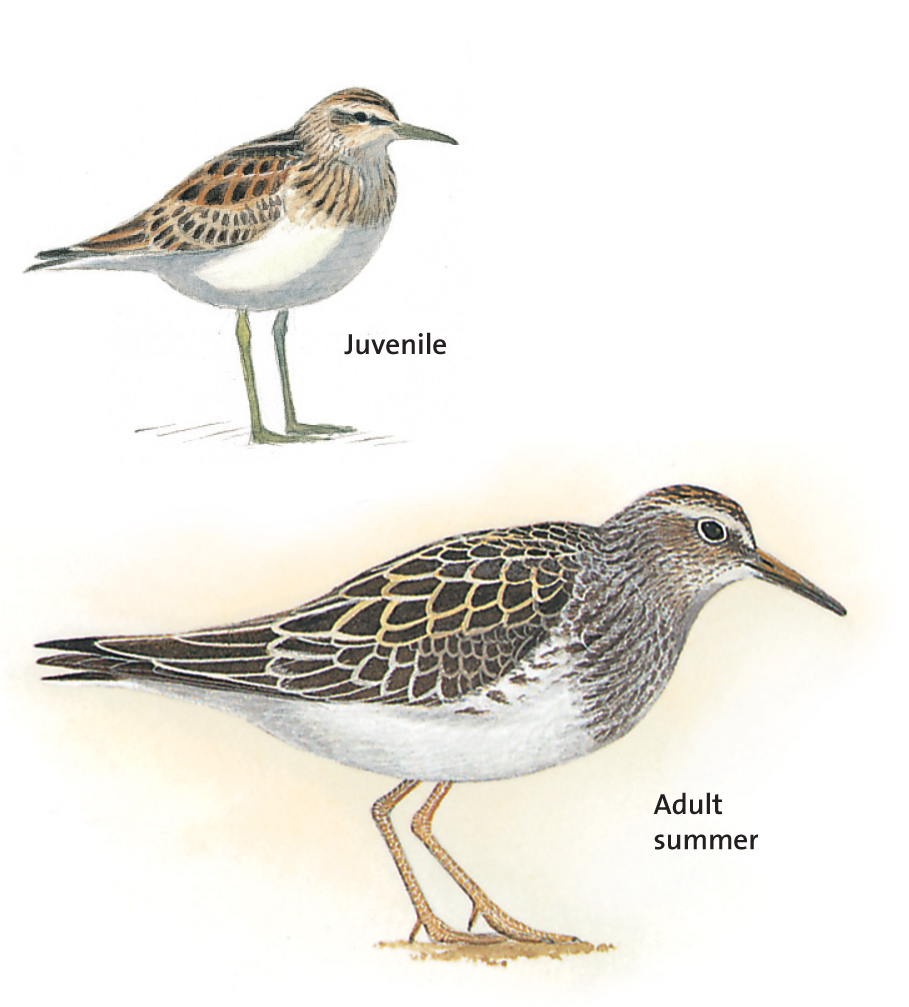
SIZE AND DESCRIPTION
19cm (female), 22cm (male). Resembles larger, small-headed Dunlin.
Mottled grey-brown on upperside, face and breast, with abrupt transition from streaked breast to clean white belly. Pale supercilium. Bill shortish, slightly downcurved, black with yellowish base, legs yellowish.
VOICE
A rasping ‘kreet’ given in flight.
HABITAT
Rare visitor from North America, more often on western coasts, the most frequent North American vagrant wader. Some make lengthy stays. Usually by freshwater, on lake shores, creeks, sometimes reservoirs.
FOOD AND HABITS
Mainly insects and other invertebrates. Has less frantic feeding action than Dunlin. Usually associates with parties of other waders.
Curlew Sandpiper
Calidris ferruginea

SIZE AND DESCRIPTION
20cm. Elegant sandpiper with a long curved bill, and a long neck and legs. Breeding plumage (rarely seen in Britain) includes a striking deep rufous colour on the breast and head. Juvenile has neatly scaled sandy brown upperparts and white flanks.
VOICE
Call a disyllabic ‘chirrip’.
HABITAT
Breeds on Russian High Arctic tundra. Migrates via Europe to Africa. In Britain most likely to be seen on passage in spring or autumn.
FOOD AND HABITS
Diet includes snails, worms and insects. Forages by probing mud rapidly with bill.
Purple Sandpiper
Calidris maritima

SIZE AND DESCRIPTION
21cm. Compact and rotund smallish wader. Plumage dark dusky grey, paler on underside but with heavy grey streaking on breast and flanks. Legs short, bright yellow-orange. Bill fairly short, slightly downcurved, dark with orange base. Narrow pale wingbars in flight.
VOICE
Quiet but flocks in flight may give a musical twitter.
HABITAT
Arctic breeder, passage migrant and winter visitor to Britain, a handful breed in Scotland. Rocky shores, more rarely beaches, often roosts on breakwaters or other man-made structures.
FOOD AND HABITS
Searches rocks at low tide for molluscs, crabs and other invertebrates, flutters up to avoid breaking waves. Often associates with Turnstones. Can be confiding.
Dunlin
Calidris alpina

SIZE AND DESCRIPTION
19cm. Slightly smaller than Sanderling, with longer bill and less conspicuous white wingbar. Summer plumage scaly black and brown above, and white below with a large black belly patch. In winter it is greyer with a whitish belly.
VOICE
Call in flight ‘treep’.
HABITAT
Breeds on northern and Arctic tundra, a few pairs breed in north Scotland. On migration and in winter is the commonest small wader on British coasts, found on flat beaches, estuaries and coastal marshland.
FOOD AND HABITS
Feeds on small invertebrates such as molluscs and worms. Nest a grassy cup well hidden on the ground.
Ruff
Philomachus pugnax
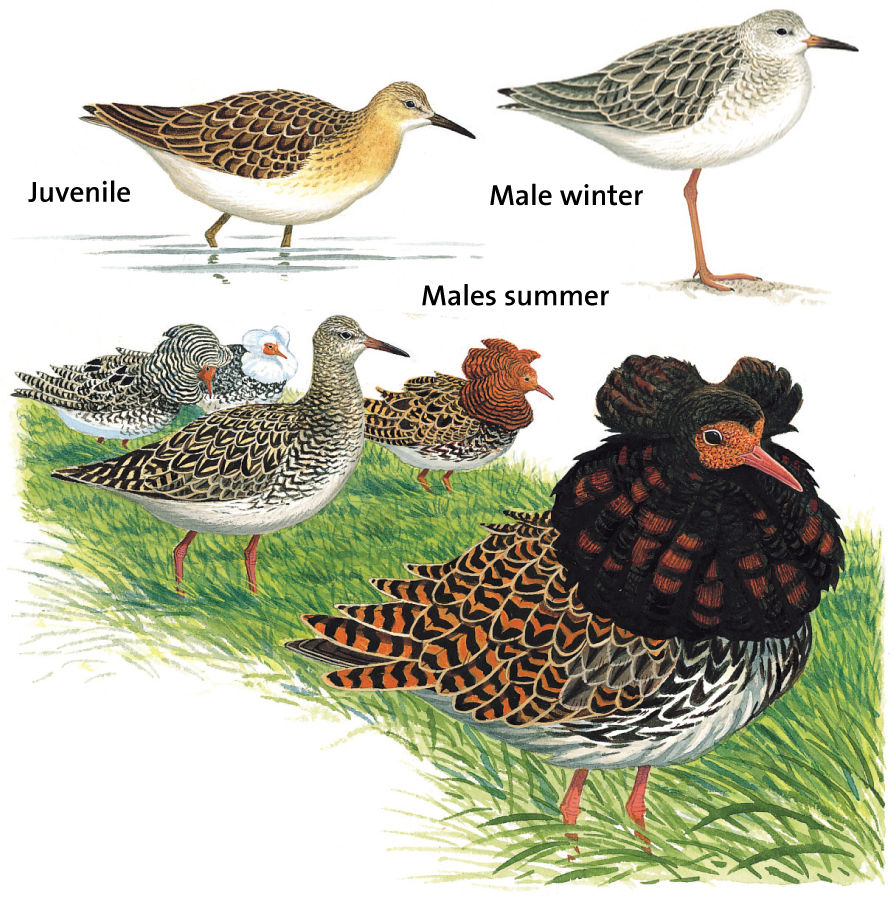
SIZE AND DESCRIPTION
Male 30cm; female 23cm. Large male has a bright ruff (or partial ruff) of feathers in summer. Female, winter male and juvenile much duller. Legs long and orange; bill slightly decurved, and orange and black in male, blackish in female.
VOICE
Usually silent.
HABITAT
Breeds central Europe, very rare British breeder (mainly eastern England). Common passage migrant on coastal lagoons and marshes, a few overwinter.
FOOD AND HABITS
Diet is mainly insects, crustaceans, molluscs, amphibians, small fish, and cereals and aquatic plants. Nest a deep cup well hidden in grass.
Jack Snipe
Lymnocryptes minimus

SIZE AND DESCRIPTION
19cm. Markedly smaller and shorter-billed than Snipe, with more yellow tones to very streaky, well-camouflaged plumage. No pale central crown stripe, but has short, narrow, dark ‘eyebrow’ line through the broad yellowish supercilium.
VOICE
Quiet, unlike Snipe rarely calls when flushed.
HABITAT
Breeds in north-east Europe, Winter visitor to western Europe, widespread. Wet, muddy, marshy fields, ditches and lake shores.
FOOD AND HABITS
Probes soft ground for worms, also takes insects and other invertebrates. Has characteristic constant bobbing action, as if spring-mounted, whether walking or standing. Very shy and discreet, reluctant to flush, and escapes with direct rather than zigzag flight.
Common Snipe
Gallinago gallinago

SIZE AND DESCRIPTION
27cm. Wader most likely to be seen when flushed, flying off in a zigzag fashion. Extremely long bill, striped yellow, and dark brown head and upperparts.
VOICE
Hoarse cry when flushed.
HABITAT
Breeds on moorland and wet grassland in Europe, in Britain commoner in north. In winter common and widespread on coastal marsh and other damp, well-vegetated habitats.
FOOD AND HABITS
Eats mainly worms; also molluscs, insects and other invertebrates. Display flight involves a 45-degree dive, with a bleating noise caused by air rushing through outspread tail feathers. Nest a deep cup well hidden in grass.
Black-tailed Godwit
Limosa limosa

SIZE AND DESCRIPTION
41cm. Breeding bird has a rufous-coloured breast. Colour outside breeding season grey-brown. In flight, a broad white wingbar and a white band on the tail above a black band distinguish it from Bar-tailed Godwit.
VOICE
Call in flight ‘wicka-wicka-wicka’. Song ‘crweetuu’.
HABITAT
Breeds on grassland and flood meadows. Winters in sheltered coastal areas in southern and western Europe. In Britain a scarce breeder in East Anglia and a widespread winter visitor.
FOOD AND HABITS
Feeds mostly on insects and larvae; also molluscs and worms. Nest a cup well hidden in a tussock.
Bar-tailed Godwit
Limosa lapponica
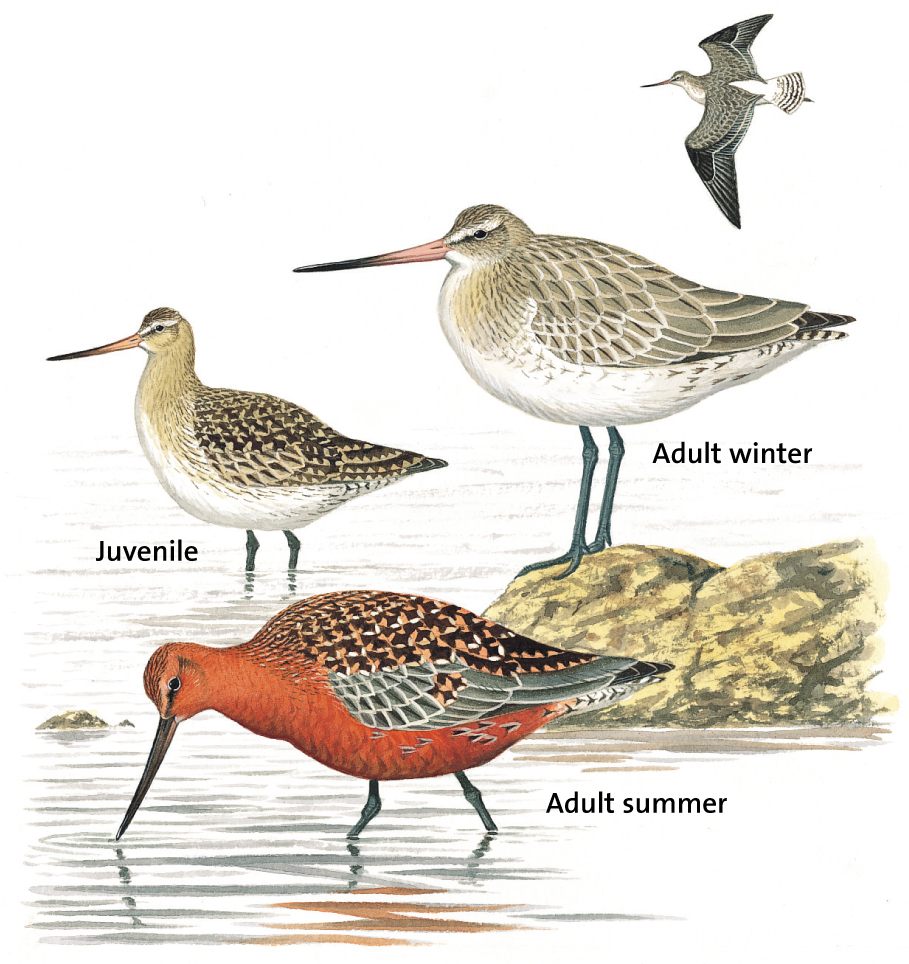
SIZE AND DESCRIPTION
37cm. Shorter legged and more robust than Black-tailed Godwit. In flight shows a distinct white rump and a barred tail.
VOICE
Flight call nasal, similar to Knot’s.
HABITAT
Breeds in Scandinavia and on tundra. Winters on tidal mudflats and sandy shores from Britain southwards.
FOOD AND HABITS
Probes mud for crabs, shrimps and marine worms in winter; insects taken mainly in summer. Nest a well-concealed scrape on the ground.
Whimbrel
Numenius phaeopus

SIZE AND DESCRIPTION
41cm. Smaller and more slender than Curlew, with a shorter bill and a markedly striped face, pale crown stripe and dark stripe above the eye. White ‘V’ shape on rump shows in flight.
VOICE
Liquid bubbling call.
HABITAT
Rare upland breeding bird in northern Scotland, fairly common passage migrant to rest of Britain, occurs on estuaries, marshes, and lake shores both coastal and inland.
FOOD AND HABITS
Eats mostly molluscs, worms and crustaceans. Nests in a well-hidden grassy cup on the ground.
Curlew
Numenius arquata
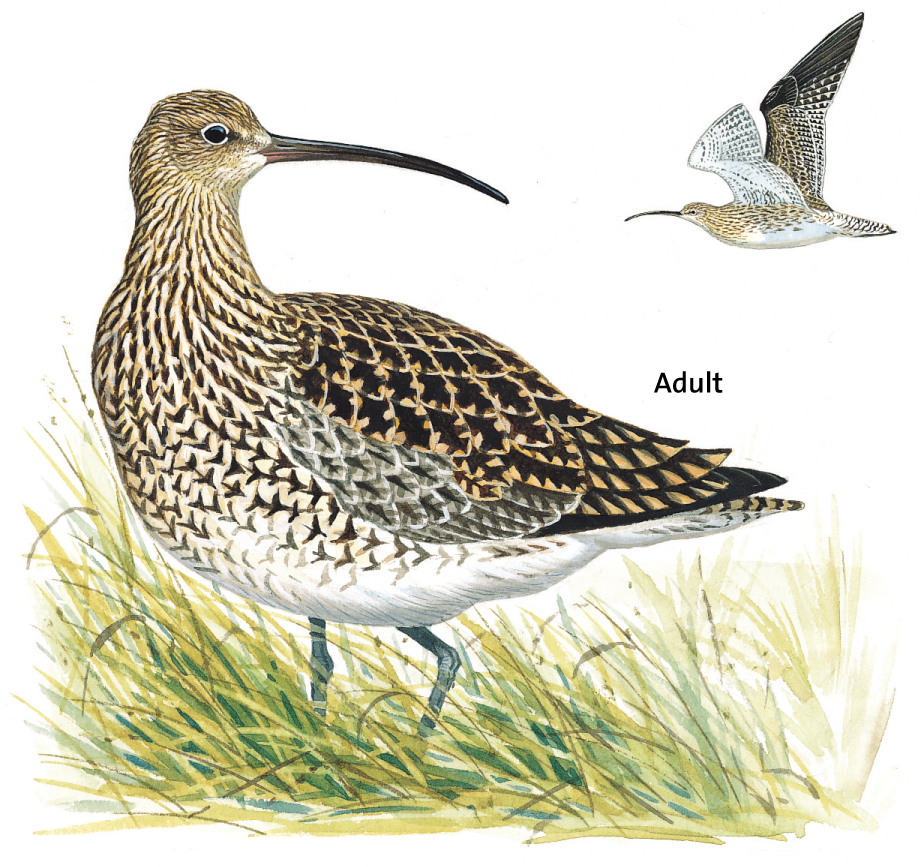
SIZE AND DESCRIPTION
54cm. Largest wader, with a very long decurved bill. Plumage streaked brown. Bigger and more robust than Whimbrel. White ‘V’ shape on rump shows in flight.
VOICE
Distinctive liquid call, ‘coor-wee’.
HABITAT
Breeds on moors and wet meadows, and winters on mudflats and fields, often on coasts. Resident in Britain.
FOOD AND HABITS
Eats mainly small invertebrates, fish and plant matter. Long bill enables it to probe mud and sand deeply. Occurs in flocks outside breeding season, but feeds more separately. Nest a grassy cup well hidden on the ground.
Spotted Redshank
Tringa erythropus

SIZE AND DESCRIPTION
30cm. Larger with longer legs and bill than Redshank. In breeding plumage uniform black with fine white speckles on wings, in winter pale grey above with white underside and strong eyestripe and supercilium. Adults in spring and autumn are transitional between these two plumages. Juvenile browner with lightly barred underside. Narrow white rump patch shows in flight. Legs red, long bill black with red base, slight ‘droop’ at tip.
VOICE
Loud ‘chu-it’.
HABITAT
Passage migrant en route from Arctic to Mediterranean, may overwinter. Shallow freshwater wetlands.
FOOD AND HABITS
Wades, probes and swims energetically in pursuit of aquatic invertebrates. Often seen singly, sometimes small groups.
Redshank
Tringa totanus
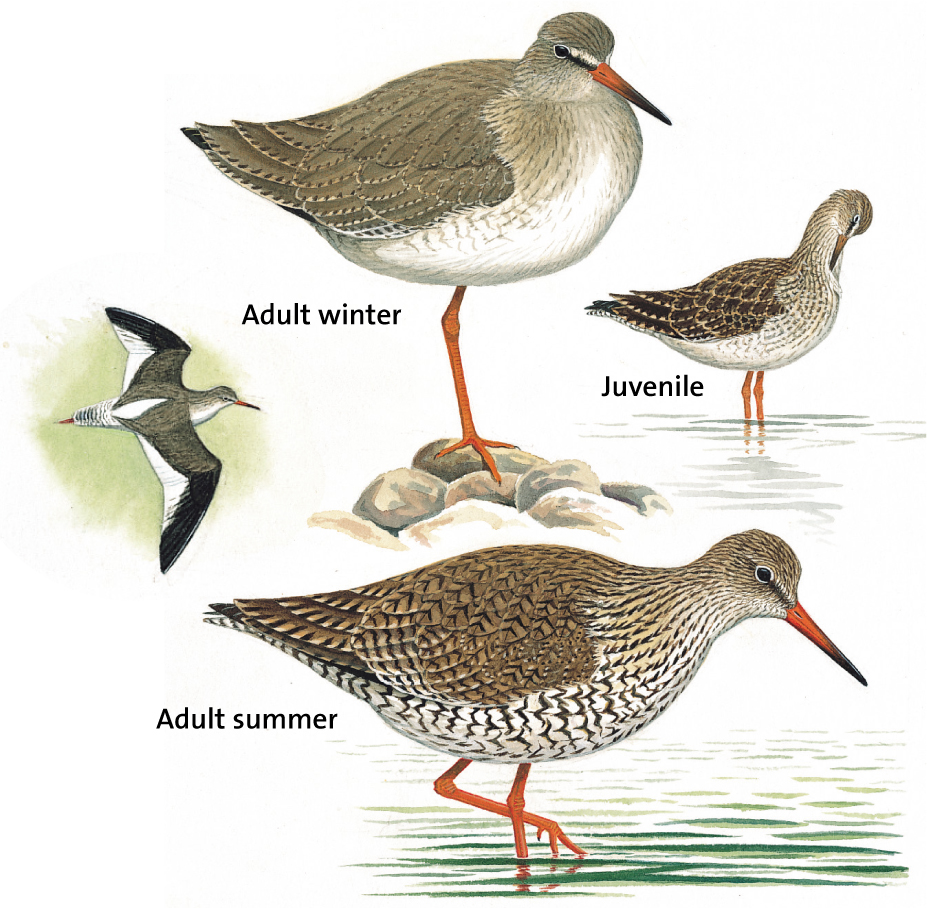
SIZE AND DESCRIPTION
28cm. Grey-brown wader with an orange-red bill and legs. Plumage greyer in winter than in summer. White rump and trailing edges to wings noticeable in flight.
VOICE
Variety of yelping calls. Song, ‘tu-udle...’, may be given in flight or from the ground.
HABITAT
Breeds on flood meadows, grassland and lowland moors both near coast and inland. Winters on coast, especially estuaries and mudflats. Most widespread on passage.
FOOD AND HABITS
Feeds mostly on invertebrates. Often perches conspicuously on posts. Nest a deep cup hidden in a grass tussock.
Greenshank
Tringa nebularia

SIZE AND DESCRIPTION
32cm. A rather pale, grey wader. Legs are green. In flight shows a white tail, rump and lower back.
VOICE
Lower pitched call than Redshank. Song, ‘ru-tu, ru-tu ...’, given in flight or while perched.
HABITAT
Breeds inland on marsh and moor edges, in northern Europe including a few pairs in Scotland. Widespread passage migrant to coastal marsh, creeks and muddy lake shores.
FOOD AND HABITS
Feeds almost entirely on invertebrates, amphibians and fish. Nests in a scrape well hidden on the ground.
Green Sandpiper
Tringa ochropus

SIZE AND DESCRIPTION
22cm. Medium-sized and relatively robust sandpiper with distinctly contrasting plumage. Upperparts very dark, underparts white with a strongly separated dark breast. Juvenile more heavily speckled than adult.
VOICE
Flight call ‘tluit-uit-uit’; warning call ‘tip tip’; song ‘tloo-i tlui’.
HABITAT
Mainly passage migrant in northern Europe, including Britain, with a few wintering in southern Britain. Occurs in all types of water body during migration. Breeds in damp forests near fresh water.
FOOD AND HABITS
Feeds on invertebrates, as well as plant fragments. Often nests high in trees in abandoned nests of passerine birds.
Wood Sandpiper
Tringa glareola
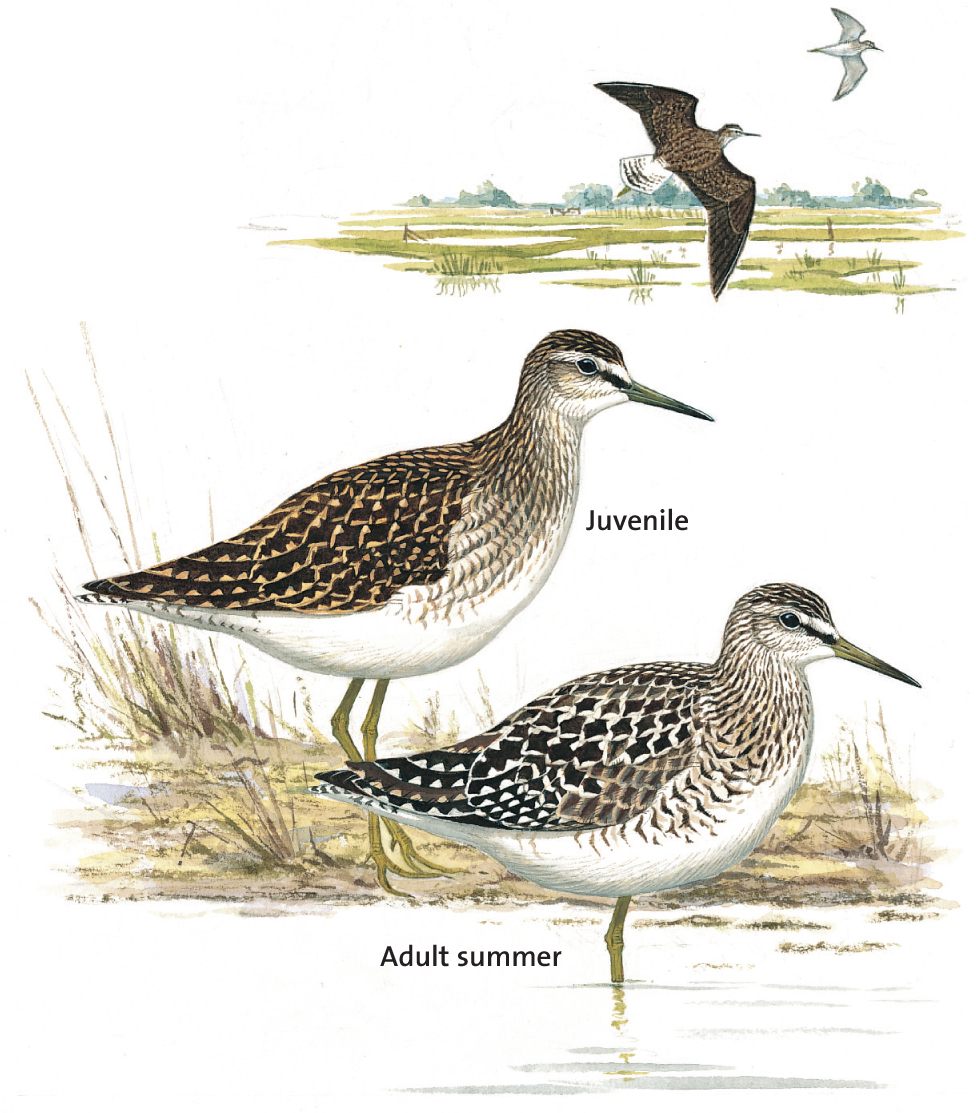
SIZE AND DESCRIPTION
20cm. Size and plumage similar to that of Green Sandpiper, but longer legged and more delicate. Upperparts mottled brownish-grey with distinct spotting and clear feather edges. Juvenile slightly darker.
VOICE
A dry ‘chiff if if’.
HABITAT
Rather uncommon passage migrant to Britain, most likely in autumn. Marshland, riverbanks and similar habitats, often near coast but not usually on mudflats.
FOOD AND HABITS
Wades in shallow water, feeding on invertebrates and plants. Nest a grassy scrape well hidden on the ground.
Common Sandpiper
Actitis hypoleucos

SIZE AND DESCRIPTION
20cm. Small wader with brown upperparts, white underparts, white sides to the rump and tail, and a white wingbar.
VOICE
Call in flight ‘twee-wee-wee’. Song more melodious.
HABITAT
Upland streams and lochs. In non-breeding season occurs on passage on inland waters such as reservoirs and sewage farms, and in coastal areas.
FOOD AND HABITS
Eats mainly invertebrates, and some plant matter. Flicks tail. Nests in a shallow scrape on the ground.
Turnstone
Arenaria interpres

SIZE AND DESCRIPTION
23cm. Boldly marked; looks black and white. Short and slightly upturned bill. Rufous markings in breeding plumage give it a tortoiseshell appearance.
VOICE
Variety of calls; typically short and nasal.
HABITAT
Breeds on tundra in Arctic regions, extremely widespread in winter on coasts worldwide including all of Britain. Rocky and stony shores favoured, also seaside towns.
FOOD AND HABITS
Diet is mainly insects, molluscs and crustaceans, which it finds by using its bill to overturn pebbles, and pieces of seaweed. Nest a shallow scrape well hidden on the ground.
Red-necked Phalarope
Phalaropus lobatus
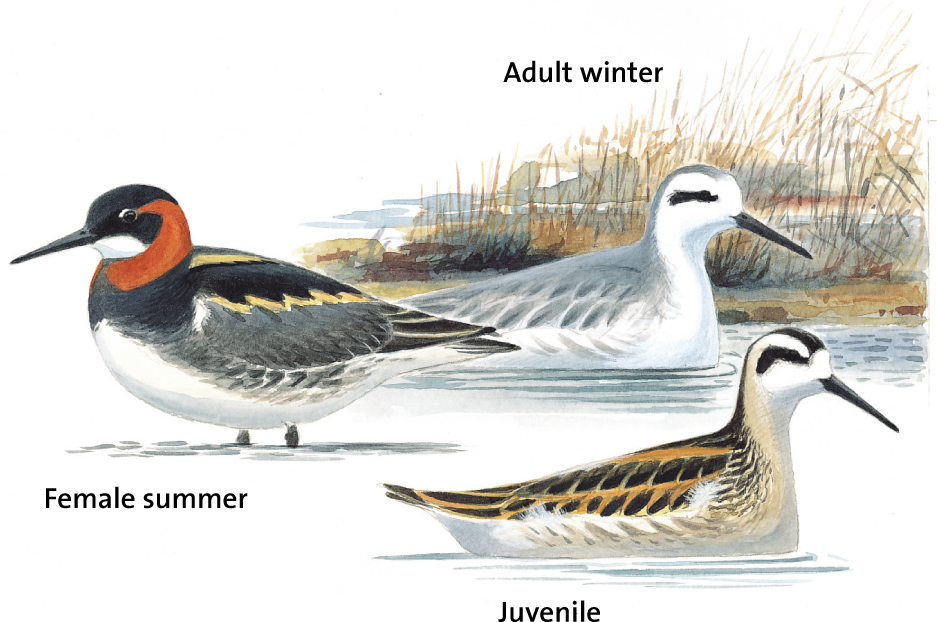
SIZE AND DESCRIPTION
18cm. Small, dainty wader, usually seen swimming. Breeding plumage dark grey above with buff ‘tramlines’, white below, with white throat and red neck-sides, female brighter than male. In winter pale grey and white, dark marking behind eye. Juvenile browner, face mostly white. Bill black and needle-like, legs dark, narrow white wingbar shows in flight.
VOICE
Sharp ‘whit’.
HABITAT
Arctic breeder, migrates to Indian Ocean. Very localised British breeder (Shetland) and uncommon passage migrant. Breeds on small, shallow marshy pools, migrants seen at sea and on coastal wetlands.
FOOD AND HABITS
Takes insects while swimming, uses spinning action to disturb them and pecks rapidly. Often very confiding.
Grey Phalarope
Phalaropus fulicarius

SIZE AND DESCRIPTION
23cm. Larger and thicker-billed than Red-necked Phalarope. Breeding plumage mainly brick-red, but in Britain most are juveniles moulting to first-winter plumage, with white head, dark crown and cheek-patch, dark upperparts, pale underparts, and variable amounts of silver-grey plumage appearing on upperside. Later in year, back and wings completely silver-grey.
VOICE
‘Whit’ or ‘zit’ call.
HABITAT
Breeds in high Arctic, winters off west Africa. Migrants passing Britain seen mainly offshore along east and south coasts. May retreat to inland lakes and pools to escape stormy weather.
FOOD AND HABITS
Feeds on land more often than Red-necked Phalarope, takes similar prey. Buoyant on the water. Very confiding.